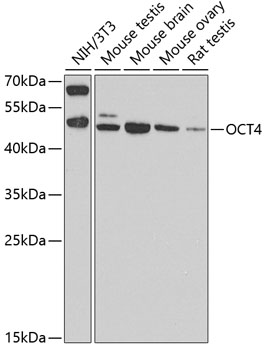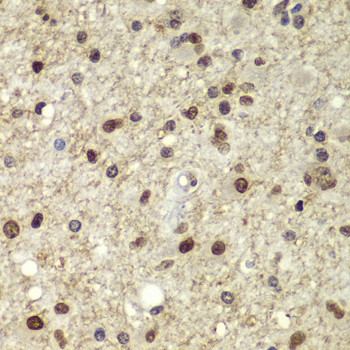Epigenetics & Nuclear Signaling Antibodies 4
Anti-OCT4 Antibody (CAB7920)
- SKU:
- CAB7920
- Product Type:
- Antibody
- Reactivity:
- Human
- Reactivity:
- Mouse
- Reactivity:
- Rat
- Host Species:
- Rabbit
- Isotype:
- IgG
- Antibody Type:
- Polyclonal Antibody
- Research Area:
- Epigenetics and Nuclear Signaling
Description
| Antibody Name: | Anti-OCT4 Antibody |
| Antibody SKU: | CAB7920 |
| Antibody Size: | 20uL, 50uL, 100uL |
| Application: | WB IHC |
| Reactivity: | Human, Mouse, Rat |
| Host Species: | Rabbit |
| Immunogen: | A synthetic peptide of human OCT4 |
| Application: | WB IHC |
| Recommended Dilution: | WB 1:500 - 1:2000 IHC 1:50 - 1:200 |
| Reactivity: | Human, Mouse, Rat |
| Positive Samples: | NIH/3T3, Mouse testis, Mouse brain, Mouse ovary, Rat testis |
| Immunogen: | A synthetic peptide of human OCT4 |
| Purification Method: | Affinity purification |
| Storage Buffer: | Store at -20'C. Avoid freeze / thaw cycles. Buffer: PBS with 0.02% sodium azide, 50% glycerol, pH7.3. |
| Isotype: | IgG |
| Sequence: | Email for sequence |
| Gene ID: | 5460 |
| Uniprot: | Q01860 |
| Cellular Location: | Cytoplasm, Nucleus |
| Calculated MW: | 30kDa/38kDa |
| Observed MW: | 50kDa |
| Synonyms: | POU5F1, OCT3, OCT4, OTF-3, OTF3, OTF4, Oct-3, Oct-4 |
| Background: | This gene encodes a transcription factor containing a POU homeodomain that plays a key role in embryonic development and stem cell pluripotency. Aberrant expression of this gene in adult tissues is associated with tumorigenesis. This gene can participate in a translocation with the Ewing's sarcoma gene on chromosome 21, which also leads to tumor formation. Alternative splicing, as well as usage of alternative AUG and non-AUG translation initiation codons, results in multiple isoforms. One of the AUG start codons is polymorphic in human populations. Related pseudogenes have been identified on chromosomes 1, 3, 8, 10, and 12. |
| UniProt Protein Function: | Oct4: Transcription factor that binds to the octamer motif (5'-ATTTGCAT-3'). Forms a trimeric complex with SOX2 on DNA and controls the expression of a number of genes involved in embryonic development such as YES1, FGF4, UTF1 and ZFP206. Critical for early embryogenesis and for embryonic stem cell pluripotency. Interacts with UBE2I and ZSCAN10. Interacts with PKM2. Interacts with WWP2. Transcriptional activity is positively regulated by PKM2. Expressed in developing brain. Highest levels found in specific cell layers of the cortex, the olfactory bulb, the hippocampus and the cerebellum. Low levels of expression in adult tissues. Belongs to the POU transcription factor family. Class- 5 subfamily. 2 isoforms of the human protein are produced by alternative splicing. |
| UniProt Protein Details: | Protein type:DNA-binding; Transcription factor Chromosomal Location of Human Ortholog: 6p21.31 Cellular Component: nucleoplasm; transcription factor complex; cytoplasm; cytosol; nucleus Molecular Function:protein binding; miRNA binding; DNA binding; sequence-specific DNA binding; ubiquitin protein ligase binding; transcription factor binding; transcription factor activity Biological Process: transcription from RNA polymerase II promoter; blastocyst development; anatomical structure morphogenesis; regulation of asymmetric cell division; regulation of transcription, DNA-dependent; regulation of gene expression; somatic stem cell maintenance; endodermal cell fate specification; response to wounding; positive regulation of transcription from RNA polymerase II promoter; mRNA transcription from RNA polymerase II promoter |
| NCBI Summary: | This gene encodes a transcription factor containing a POU homeodomain that plays a key role in embryonic development and stem cell pluripotency. Aberrant expression of this gene in adult tissues is associated with tumorigenesis. This gene can participate in a translocation with the Ewing's sarcoma gene on chromosome 21, which also leads to tumor formation. Alternative splicing, as well as usage of alternative AUG and non-AUG translation initiation codons, results in multiple isoforms. One of the AUG start codons is polymorphic in human populations. Related pseudogenes have been identified on chromosomes 1, 3, 8, 10, and 12. [provided by RefSeq, Oct 2013] |
| UniProt Code: | Q01860 |
| NCBI GenInfo Identifier: | 42560248 |
| NCBI Gene ID: | 5460 |
| NCBI Accession: | NP_002692 |
| UniProt Secondary Accession: | Q01860,P31359, Q15167, Q15168, Q16422, Q5STF3, Q5STF4 A6NCS1, A6NLL8, D2IYK4, |
| UniProt Related Accession: | Q01860 |
| Molecular Weight: | 30,085 Da |
| NCBI Full Name: | POU domain, class 5, transcription factor 1 isoform 1 |
| NCBI Synonym Full Names: | POU class 5 homeobox 1 |
| NCBI Official Symbol: | POU5F1 |
| NCBI Official Synonym Symbols: | OCT3; OCT4; OTF3; OTF4; OTF-3; Oct-3; Oct-4 |
| NCBI Protein Information: | POU domain, class 5, transcription factor 1; octamer-binding protein 3; octamer-binding protein 4; POU domain transcription factor OCT4; octamer-binding transcription factor 3; POU-type homeodomain-containing DNA-binding protein |
| UniProt Protein Name: | POU domain, class 5, transcription factor 1 |
| UniProt Synonym Protein Names: | Octamer-binding protein 3; Oct-3; Octamer-binding protein 4; Oct-4; Octamer-binding transcription factor 3 |
| UniProt Gene Name: | POU5F1 |
| UniProt Entry Name: | PO5F1_HUMAN |








